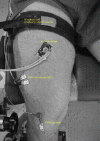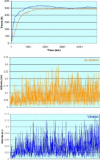The Influence of Vibration on Muscle Activation and Rate of Force Development during Maximal Isometric Contractions
- PMID: 24497816
- PMCID: PMC3896109
The Influence of Vibration on Muscle Activation and Rate of Force Development during Maximal Isometric Contractions
Abstract
At present there appears to be a need for research conducted on the effects of vibration on the contractile ability of skeletal muscle tissue. The aim of this study was to address this issue by examining the effects of a superimposed muscle/tendon vibration at 50.42±1.16 Hz (acceleration 13.24 ± 0.18ms(-2): displacement ≈5mm) on muscular activation and maximal isometric contraction. Sixteen participants with a mean age, body mass, and height of 22 ± 4.4 years, 73.2 ± 11.7 kg and 173.1 ± 9.7 cms, respectively, were recruited for this study. Electromyography and accelerometry from the rectus femoris, and maximal isometric force data characteristics were collected from the dominant limb under conditions of vibration, and no-vibration. A superimposed 50 Hz vibration was used during the contraction phase for the maximal isometric leg extension for the condition of vibration. A one-way ANOVA revealed no significant (p > 0.05) differences between the vibration and no-vibration conditions for peak normalized EMGRMS (84.74% Vs 88.1%) values. An ANOVA revealed significant (p > 0.05) differences between the peak fundamental frequencies of the FFT between the conditions vibration (27.1 ± 12.2 Hz) and no-vibration (9.8 ± 3.5 Hz). Peak isometric force, peak rate of force development, rate of force development at times 0.05, 0.01, 0.1, 0.5 seconds, and rate of force development at 50, 75, and 90% of peak force were not significantly different. The results of this study suggest that the application of vibration stimulation at 50 Hz during the contraction does not contribute to muscle activation, or enhance force production for maximal isometric contractions. Key PointsThe application of a vibratory stimulation to the human body increases the normal acceleration resulting in an increase in force and a change in performanceThis study was to address this issue by examining the effects of a direct superimposed muscle/tendon vibration at 50 Hz on isometric strength characteristicsNo improvement or change in isometric force or rate of force developmentNo changes to peak normalized EMGRMS values.
Keywords: Strength; isometric; muscle activation; oscillations; peak.
Figures
Similar articles
-
Effects of different vibration frequencies, amplitudes and contraction levels on lower limb muscles during graded isometric contractions superimposed on whole body vibration stimulation.J Rehabil Assist Technol Eng. 2019 Feb 7;6:2055668319827466. doi: 10.1177/2055668319827466. eCollection 2019 Jan-Dec. J Rehabil Assist Technol Eng. 2019. PMID: 31245030 Free PMC article.
-
Acute effect of tendon vibration applied during isometric contraction at two knee angles on maximal knee extension force production.PLoS One. 2020 Nov 13;15(11):e0242324. doi: 10.1371/journal.pone.0242324. eCollection 2020. PLoS One. 2020. PMID: 33186411 Free PMC article.
-
Fatiguing effects of indirect vibration stimulation in upper limb muscles: pre, post and during isometric contractions superimposed on upper limb vibration.R Soc Open Sci. 2019 Oct 2;6(10):190019. doi: 10.1098/rsos.190019. eCollection 2019 Oct. R Soc Open Sci. 2019. PMID: 31824681 Free PMC article.
-
Effects of adding whole body vibration to squat training on isometric force/time characteristics.J Strength Cond Res. 2010 Jan;24(1):171-83. doi: 10.1519/JSC.0b013e3181c3b641. J Strength Cond Res. 2010. PMID: 19924007 Clinical Trial.
-
The effects of timing and application of vibration on muscular contractions.Aviat Space Environ Med. 2002 Feb;73(2):119-27. Aviat Space Environ Med. 2002. PMID: 11846180
Cited by
-
Does the motor unit synchronization induced by vibration enhance maximal voluntary isometric contraction force? A randomized controlled double-blind trial.J Musculoskelet Neuronal Interact. 2018 Sep 1;18(3):339-347. J Musculoskelet Neuronal Interact. 2018. PMID: 30179211 Free PMC article. Clinical Trial.
-
Efficacy of a whole-body vibration intervention to effect exercise tolerance and functional performance of the lower limbs of people with chronic obstructive pulmonary disease.BMC Pulm Med. 2012 Nov 26;12:71. doi: 10.1186/1471-2466-12-71. BMC Pulm Med. 2012. PMID: 23181339 Free PMC article. Clinical Trial.
-
The effect of programed physical activity measured with levels of body balance maintenance.Med Sci Monit. 2014 Oct 6;20:1841-49. doi: 10.12659/MSM.889521. Med Sci Monit. 2014. PMID: 25284349 Free PMC article.
-
Acute and chronic neuromuscular adaptations to local vibration training.Eur J Appl Physiol. 2017 Oct;117(10):1939-1964. doi: 10.1007/s00421-017-3688-8. Epub 2017 Aug 1. Eur J Appl Physiol. 2017. PMID: 28766150 Review.
-
Supra-threshold vibration applied to the foot soles enhances jump height under maximum effort.PLoS One. 2022 Apr 6;17(4):e0266597. doi: 10.1371/journal.pone.0266597. eCollection 2022. PLoS One. 2022. PMID: 35385540 Free PMC article.
References
-
- Barry D.T., Cole N.M. (1990) Muscle sounds are emitted at the resonant frequencies of skeletal muscle. IEEE Transactions on Biomedical Engineering 37, 525-31 - PubMed
-
- Bosco C., Cardinale M., Tsarpela O. (1999a) Influence of vibration on mechanical power and electromyogram activity in human arm flexor muscles. European Journal of Applied Physiology 79, 306-11 - PubMed
-
- Bosco C., Colli R., Cardinale M., Tsarpela O., Madella A., Tihanyi J., Viru A. (1999b) Adaptive responses of human skeletal muscle to vibration exposure. Clinical Physiology 19, 183-7 - PubMed
-
- Burke J.R., Schutten M.C., Koceja D.M., Kamen G. (1966) Age-dependant effects of muscle vibration and the Jendrassik maneuver on the patellar tendon reflex response. Archives of Physical Medicine and Rehabilitation 77, 600-4 - PubMed
-
- Cohen J. (1988). Statistical power analysis for the behavioral sciences (2nd). New Jersey: Lawrence Erlbaum
LinkOut - more resources
Full Text Sources


